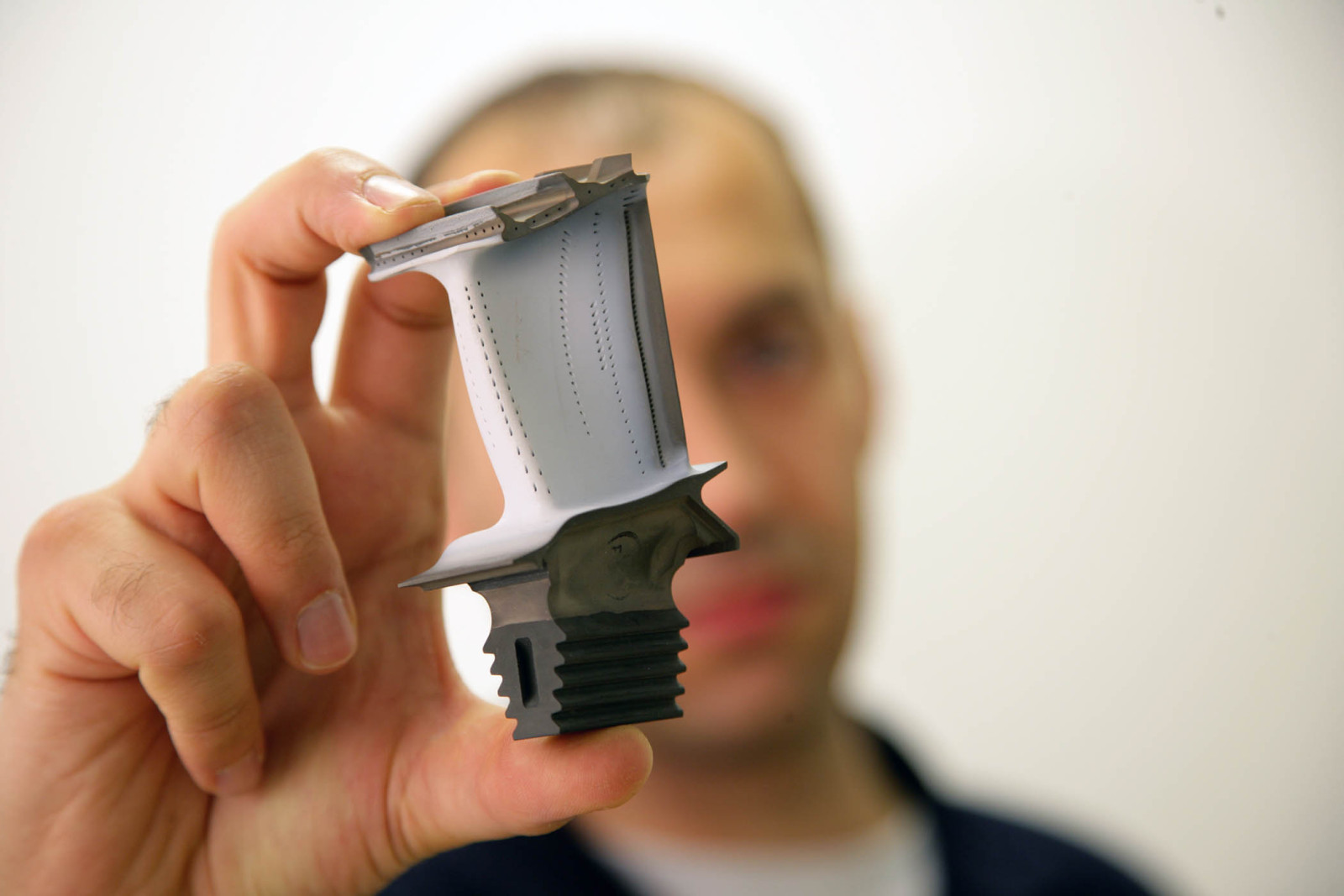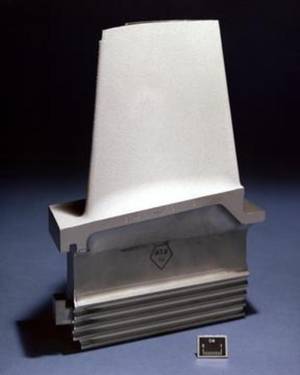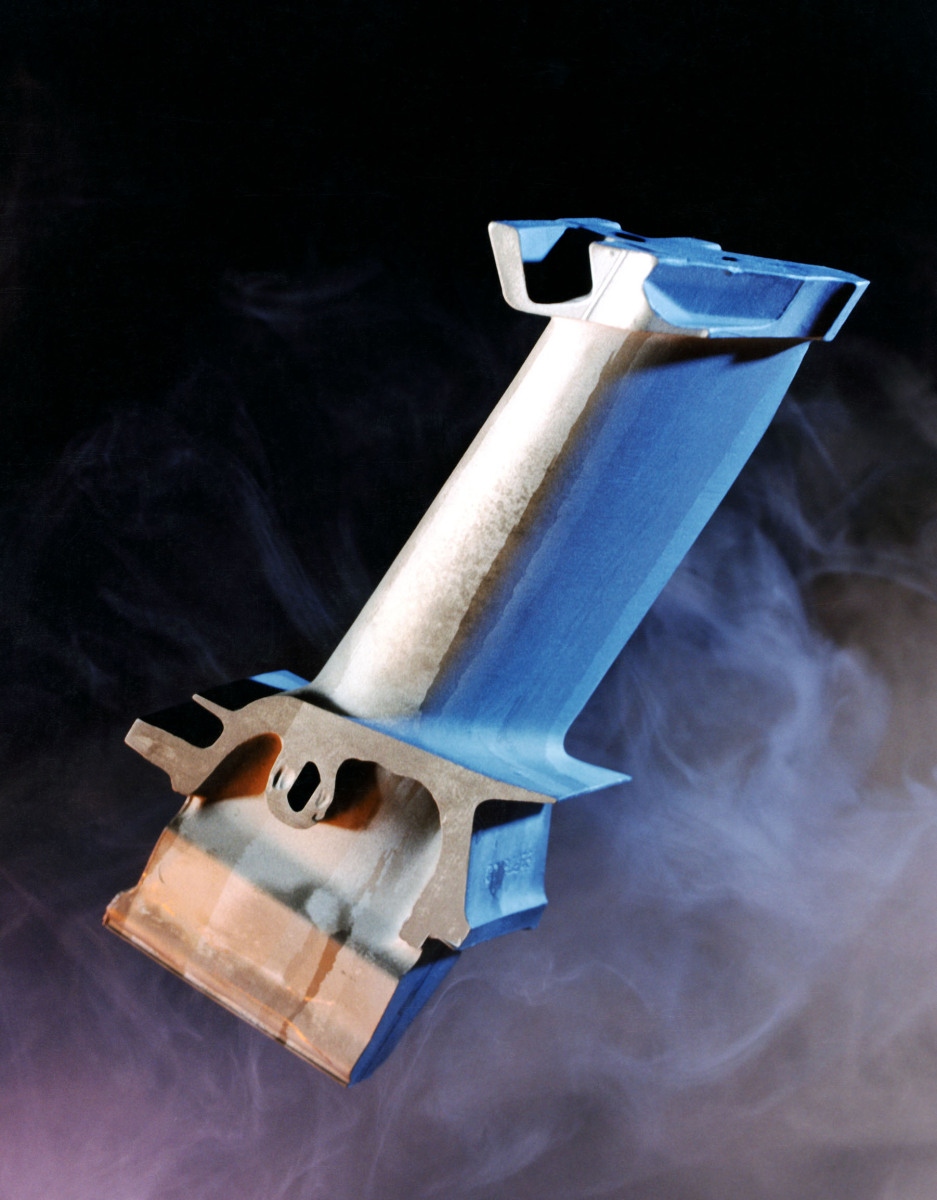The inside of an aircraft jet engine is a harsh and complex environment. Components spinning at more than 10,000 times per minute are exposed to temperatures that vary from -50°C up to 2000°C. Finding materials able to withstand these conditions is already tricky enough, but because efficiency increases the hotter an engine runs, the race is on to find materials that are able to handle even harsher environments in order to cut fuel bills and reduce the environmental impacts of aviation.
 The rear part of the engine, known as the turbine section, is the hottest region. Here there are rotating discs with metallic blades attached which, when in motion, can experience temperatures in excess of 1500°C and loads equivalent to suspending a heavy truck on each blade. Withstanding such aggressive conditions requires the use of a special class of materials because most ordinary metals would simply melt away.
The rear part of the engine, known as the turbine section, is the hottest region. Here there are rotating discs with metallic blades attached which, when in motion, can experience temperatures in excess of 1500°C and loads equivalent to suspending a heavy truck on each blade. Withstanding such aggressive conditions requires the use of a special class of materials because most ordinary metals would simply melt away.
 These special metals are called nickel (Ni) "super"-alloys. They are made up of nickel mixed, or "alloyed", with small amounts of about 8 to 10 other metallic elements, mainly aluminium (Al). Different combinations of metals give different performances at higher temperatures. This knowledge, combined with engineering design techniques to remove features from the material that can weaken a blade at high temperature, has endowed these metal mixtures with extraordinary mechanical and chemical properties.
These special metals are called nickel (Ni) "super"-alloys. They are made up of nickel mixed, or "alloyed", with small amounts of about 8 to 10 other metallic elements, mainly aluminium (Al). Different combinations of metals give different performances at higher temperatures. This knowledge, combined with engineering design techniques to remove features from the material that can weaken a blade at high temperature, has endowed these metal mixtures with extraordinary mechanical and chemical properties.
However, the remarkable performance of these materials is still not enough on its own, and other design tricks are also needed to keep the blades turning. This includes cooling the blades by passing air over them and using ceramic coatings to protect the surfaces. These tricks allow modern jet engines to run at temperatures of over 1500°C, which is actually much higher than the melting temperature of the superalloy.
In addition to being able to take the heat, the materials need to be as light and strong as possible, and "creep" also needs to be considered. This is the process by which materials gradually alter their shapes when they are exposed to loads and high temperatures and the creep strength is an indication of how readily this happens. It's analogous to the way in which the handles of plastic carrier bags stretch and tear if you overload the bag with heavy shopping. In the case of turbine blades, under conditions of high rotational speeds and temperatures, the lower the elongation the better.
At elevated temperatures, materials also become more prone to react chemically with components of the atmosphere. This leads to oxidation, which can severely degrade the material in the same way that rust weakens iron railings. This means blade materials also need to be oxidation-resistant.
Nickel superalloys have been used for turbine engines for the last fifty years, but the rate of improvement in performance is no longer staying in step with demand. This means that, soon, further developments to make engines more efficient will be hindered by the inability of the materials to cope with the higher temperatures. And given the increasing demand for air travel (the numbers of passengers are expected to double in the next 15 years) and the growing commercial and environmental pressures, materials scientists need to delve deeper into "hotter materials" which can eventually replace nickel-based superalloys so that engines can continue to run at even higher temperatures and with greater efficiencies.
Designing New Materials
 The fundamental basis for designing the new materials has been inspired by what we already know about nickel-based superalloys. When nickel superalloys are studied at the micron-level - meaning one thousandth of a millimeter - it can be seen that they comprise two different components or "phases". One of the phases is based on nickel only; the other phase is a compound between nickel and aluminium and is called an "intermetallic" phase. Intermetallic phases are formed when atoms from different metals arrange themselves into a very regular pattern containing a specific ratio of each element. For instance, in nickel superalloys, the intermetallic is formed when three nickel atoms associate with one aluminium atom in a cube configuration to form Ni3Al, where each atom occupies a very specific place in the cube. This distinctive and ordered structure displays radically different properties when compared to the pure metals on their own. At 1000°C, Ni3Al can withstand a load equivalent to 400 megapascals, which is like piling 400 million apples onto an area equivalent of a medium-sized wall painting. At these temperatures nickel alone would deform like butter and aluminium would simply melt. The intermetallic mixture of the two, however, holds fast.
The fundamental basis for designing the new materials has been inspired by what we already know about nickel-based superalloys. When nickel superalloys are studied at the micron-level - meaning one thousandth of a millimeter - it can be seen that they comprise two different components or "phases". One of the phases is based on nickel only; the other phase is a compound between nickel and aluminium and is called an "intermetallic" phase. Intermetallic phases are formed when atoms from different metals arrange themselves into a very regular pattern containing a specific ratio of each element. For instance, in nickel superalloys, the intermetallic is formed when three nickel atoms associate with one aluminium atom in a cube configuration to form Ni3Al, where each atom occupies a very specific place in the cube. This distinctive and ordered structure displays radically different properties when compared to the pure metals on their own. At 1000°C, Ni3Al can withstand a load equivalent to 400 megapascals, which is like piling 400 million apples onto an area equivalent of a medium-sized wall painting. At these temperatures nickel alone would deform like butter and aluminium would simply melt. The intermetallic mixture of the two, however, holds fast.
Intermetallic compounds make up the largest class of materials known today and about 300 other intermetallics like Ni3Al are known to have a high melting temperature and are therefore worthy of consideration for high temperature services. That said, the research for new materials is still in its infancy although researchers have already discovered some potentially viable alloys for turbine engine applications.
Niobium-Silicon (Nb-Si) Alloys
Nb-Si alloys have been identified as one of the suitable candidates for high temperature environments. The reason for choosing niobium as a base metal is because of its very high melting temperature of about 2400°C, around 1000°C higher than nickel. The alloy Nb5Si3, also called the 5-3 silicide, is also known to have excellent creep properties. The presence of a niobium phase in conjunction with Nb5Si3 also increases damage tolerance because Nb5Si3 by itself is very fragile. However, these alloys are not perfect; although they can provide substantial oxidation resistance at temperatures in excess of 1100°C, ironically they have poor resistance at lower temperatures, and this a major issue.
Molybdenum-silicon-boron (Mo-Si-B) alloys
The best performing alloys with a reasonable balance of properties are those with boron additions (known as the Mo-Si-B system). The alloys in this category comprise two intermetallic phases in addition to a molybdenum-based phase: a Mo3Si (called the 3-1 silicide) and a Mo5SiB2 (named T2) phase. Although the creep strength for these alloys at 1200°C doesn't match that of Nb-Si alloys, the Mo5SiB2 phase gives them superior oxidation characteristics. Mo5SiB2 creates a continuous, impervious oxide layer on the surface, preventing further oxidation of the underlying alloy. Similar to the Nb-Si system, the presence of Mo-rich phase translates into the alloys having an overall better fracture resistance.
When compared to traditional superalloys the Nb-Si and Mo-Si-B alloys have some advantages in terms of physical and mechanical properties. These aren't the only options though and, ideally, materials will be found that are better across the whole range of desirable traits. Many of the properties we look for are in conflict with each other, so we will need to make trade-offs with more credit given to the more critical characteristics.
With all that in mind, the heat is definitely now on to find replacement materials that can withstand the higher temperatures of modern, and future, jet engines.
- Previous Food Date Coding Decoded
- Next I'm a Civet: Get me out of here!











Comments
Add a comment